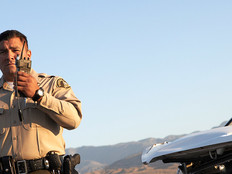Tablets Boost Training, Agencies Find
In May 2011, earthquakes ranging from 6.0 to 7.7 on the Richter scale rocked eight states, from Alabama to Illinois, causing billions of dollars in damage. Or they would have, if the quakes weren’t just a simulation created as part of a massive government training exercise.
The National Level Exercise 2011 brought together more than 10,000 employees of the Federal Emergency Management Agency, Homeland Security Department and other federal agencies, as well as nearly 8,000 members of the private sector. This four-day dress rehearsal for disaster also introduced a new player to the stage: the Apple iPad.
For NLE11, FEMA outfitted a handful of emergency responders in Jonesboro, Ark., with tablets running a mobile version of a data simulation environment called SUMMIT, short for Standard Unified Modeling, Mapping & Integration Toolkit. Using the SUMMIT app, responders at the disaster site could call up a 3D satellite map of the area with each building color-coded in green, yellow or red, based on the damage it had sustained. Green buildings were safe to enter, yellow buildings had suffered some damage, and red buildings were in danger of imminent collapse.
“In the past, exercise participants would fax this kind of information to each other,” says Jalal Mapar, SUMMIT program manager for DHS’ Science and Technology Directorate. “Last year, we gave them visual data on their iPads using the kind of three-dimensional views you get in the gaming world. About 15 minutes into the exercise, I was getting calls from my guys in Jonesboro asking for more iPads. They were a huge hit because they made the exercise so much more realistic.”
DHS and FEMA are among several agencies exploring the use of tablets as training tools, thanks to their portability, flexibility and potential cost savings. Others include the Air Force and DHS’ Federal Law Enforcement Training Center.
FLETC recently initiated a pilot called TRAIN 21 that when fully implemented will allow students to access a learning portal hosted on Microsoft SharePoint. To date, approximately 200 students have been outfitted with tablet PCs in the preliminary testing.
19%
of federal employees are expected to use tablets by 2013.
Source: Mobile Powered Government Survey (MeriTalk, Feburary 2012)
Digitizing its learning materials will not only save money on paper and printing, says TRAIN 21 Program Manager Monty Thrasher, it will also make the training FLETC provides to future law enforcement professionals more efficient and effective.
“We’re hoping to move to an interactive system where all the materials they need are embedded on the tablet,” he says. “So as they’re reading about how to do ‘X,’ there will be a video showing them how to do it on the page alongside that description.”
Tablets Take Off
For the Air Force’s Air Mobility Command, tablets represent an opportunity to cut down on paper materials while boosting the AMC’s ability to update vital information to aircrew members at any time and in any location. In February, the AMC ordered 63 iPad 2 electronic flight bag devices for field testing. If the tests prove successful and funding is approved, the AMC plans to outfit all 18,000 aircrew members with their own iPads by the end of this year, says Maj. Mike Andrews of the Air Force Air Mobility Command.
A big driver behind the move to electronic flight bags is the money the Air Force can save by eliminating paper. Each plane requires an average of approximately 70 pounds of paper charts, which must be updated every 28 days. In addition, every member of the crew must carry technical orders, flight manuals and other paper material that weigh an average of 30 to 40 pounds. By moving to electronic documents delivered via tablet, the AMC estimates it will save $5.7 million in printing, distribution and fuel costs each year.
78%
of federal IT managers say tablet security is their biggest concern.
Source: Mobile Powered Government Survey (MeriTalk, Feburary 2012)
Just as important, the use of tablets will enable crews to watch training videos at any location, and access information in a more sophisticated way, says Andrews.
“Replacing paper in the cockpit goes beyond simply using a PDF reader for publications and flight manuals,” he says. “For example, aeronautical charts and airport approach information require a more sophisticated, interactive method to recall information that a simple PDF reader cannot offer. The bottom line is that our aircrews will be able to accomplish their mission much more safely and effectively by having a single-touch reference that is standardized across the entire Air Mobility Command fleet.”
Still, using consumer-grade devices in a rugged environment can prove problematic, warns Phillip Redman, research vice president at Gartner Research.
“Any time you can replace a textbook or manual with something lighter or thinner, that’s a good thing,” he says. “But you don’t want those iPads to freeze up or crash while they’re on the flight deck. The use of these devices will be limited until they develop an industrial version that’s more suitable to harsh environments.”
Field of Screens
Even the brief exposure to using iPads during the National Level Exercise has first responders itching to take the training wheels off and use them in the field, Mapar says.
“The emergency management community has realized how much they have to gain from using tablets — whether it’s filling out a form on the fly, pulling down information from the cloud, doing a video conference, or looking at simulated damage in an exercise,” he says. “It’s all about situational awareness. The value tablets can provide is tremendous.”








